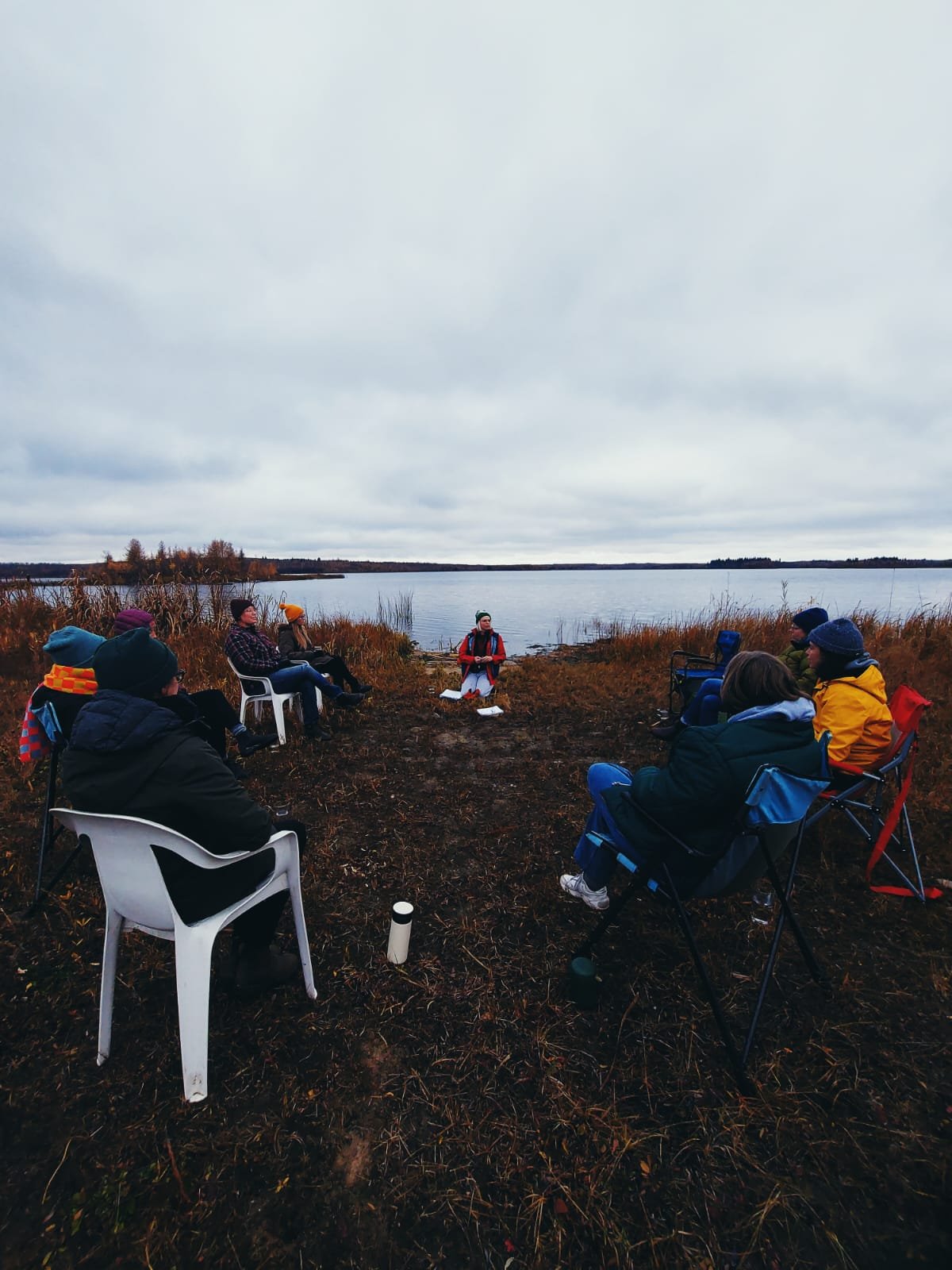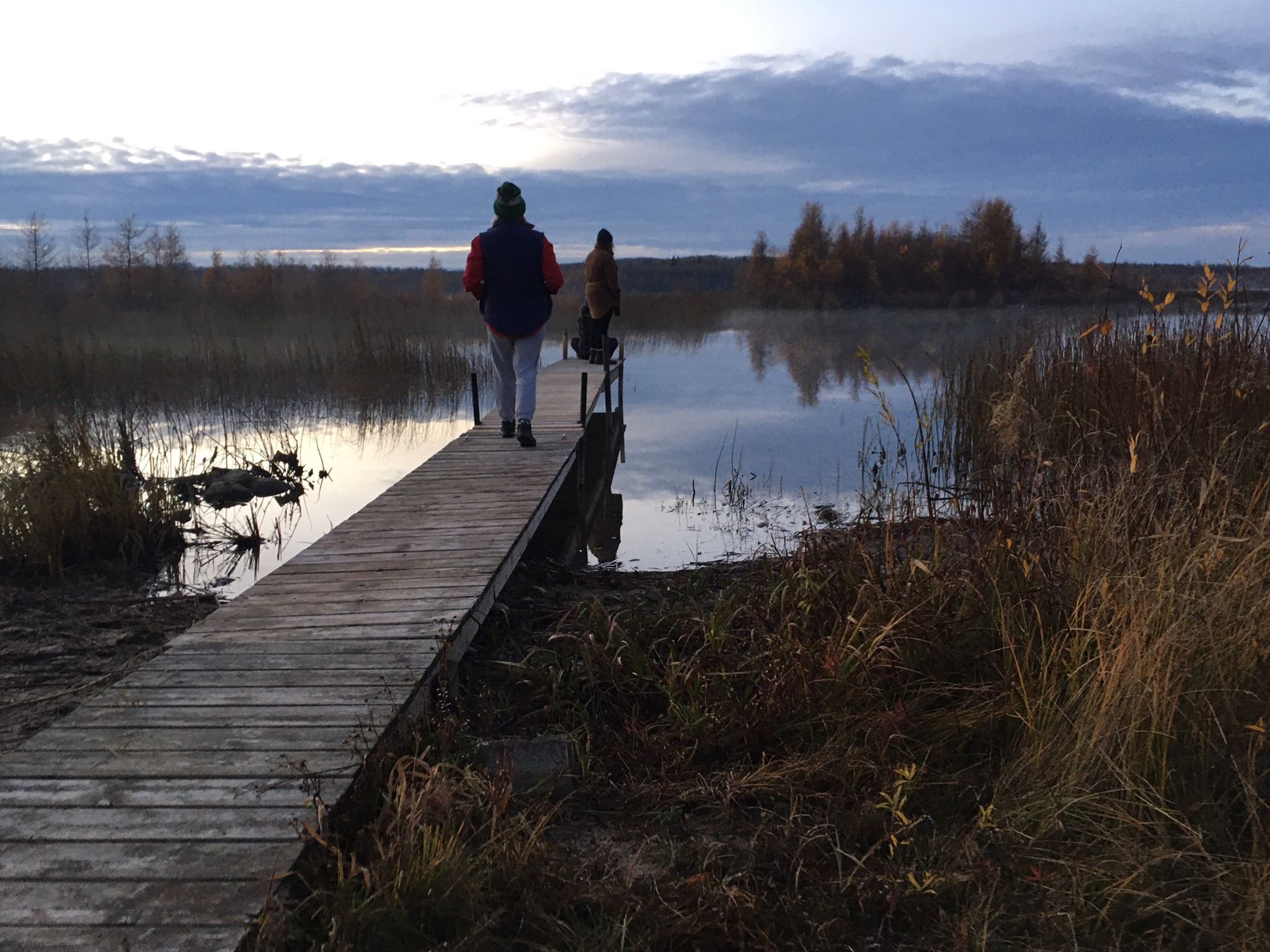Reflections on a Retreat Or, How to be in Your Body (even when it’s kinda a nightmare in there)
We all needed this very badly. That was the consensus that emerged again and again during our weekend together this past October. After two and a half years of varying degrees of pandemic induced isolation, we all needed time like this together in person very badly.
There were ten of us––three facilitators, two cooks, and five participants––gathered for the weekend at a remote cabin on a lake a few hours north of Edmonton. What had brought us together was simple: a common desire to feel more connected.
The retreat was titled “Coming Home to Ourselves: Practicing Collective Grief, Joy & Liberation While the World Unravels.” Among other things, it included guided meditation, personal reflection, group sharing, and lots of time being slow and quiet outside. One of its goals was to provide an opportunity for all of us to experience something we all needed––the beauty, simplicity and, most importantly, the inevitability of connection.
As facilitators, we were operating with the belief that connection is not so much something that we make happen, but something we let happen.
Because on the most basic level, our connection to ourselves and to the world around us is inherent and unconditional. It is our birthright. It is always there, whether we feel it or not. It is not something we must earn or effort our way into, but rather, is something we can, in any moment, choose to remember and experience.
Sounds nice, right? Experiencing connection is, after all, what we all said we wanted, myself included. But the thing is, experiencing connection can quite often be uhh… painful. It’s not always just a series of pleasant sensations and thoughts. It can be uncomfortable. And complicated. And often deeply confusing.
Or at least it was for me. Let me tell you what happened.
Each morning of the retreat, we started with a simple movement practice aimed at supporting connection with our bodies. On Saturday morning, Steph facilitated. After a communal breakfast of elaborately topped oatmeal, she led us into the common area, connected her phone to the bluetooth speaker, and gave us one simple instruction: move your bodies in whatever way feels right.
The song she played was called Loosen Loosen by Aly Halpert. We started off awkward and stilted but soon enough all of us were stretching, swaying, or dancing along to the gentle lyrics of a song that can pretty accurately be called an adult lullaby. It felt like easing into a warm bath. It felt like Sunday afternoon. It felt like exactly what we needed to hear in order to shake ourselves loose from the body-numbing reality of daily life under late-stage capitalism.
“Loosen, loosen, baby
you don't have to carry
the weight of the world in your muscles and bones
let go, let go, let go.”
This verse was repeated four times––just enough for it to knead itself under our skin and start sinking into our bones. You could pretty much hear the collective exhale as we let our awareness be guided back, ever so gently, to the visceral reality of our bodies. We stretched out stiffness in our bodies, massaged sore muscles. We sunk into the experience of being alive in a body, feeling the weight and texture of ourselves, feeling our presence in a roomful of other bodies, listening to the same song, breathing the same air.
Returning to your body after a long time can feel good, like a warm bath: familiar, relieving, and satisfying. But it can also feel jarring, disorienting and deeply uncomfortable. For me, returning to my body during the movement practice felt very good. The next exercise which invited us to stay with our bodies––was another story.
After the movement practice, Steph guided us into a centering meditation she had learned through the lineage of Generative Somatics and Strozzi Somatics. The practice invites the meditator to bring awareness to 3 different dimensions of their body––the length, width, and depth––as a way to feel their way back into embodied connection.
It was lovely and profound and full of beautiful reminders of our deep interconnectedness.
And I hated it.
I’d done this practice before, many times actually. It’s a powerful practice. But the very same thing that makes it powerful (it’s ability to reconnect you with parts of your body you’ve been disassociated from) is precisely what makes it so difficult.
Like everyone else’s body, my body holds memories of past trauma. And, like all bodies, what it longs for most is also what it fears most and therefore avoids––connecting to the very places in my body that hold this trauma.
Suffice to say, the longer I tried to stay connected to my body during this meditation, the more my awareness came into contact with a part that I had long been avoiding. Quiet at first and then louder and louder, it felt like there was this silent internal scream welling up in me, coming up from the depths of my unconscious, desperate to be acknowledged.
Clearly my unconscious had some shit she wanted me to deal with.
I tried to be a good meditator and simply sit with the screaming, letting my awareness hold it softly and lightly. However, this felt next to impossible. I kept getting pulled away by biting thoughts about how this screaming must mean something was very wrong with me. It felt impossible to stay in connection with myself and my body. If connection was our birthright, I thought, maybe I’d gotten passed over.
While all this self-criticism was ricocheting around my mind, I heard Steph bring the meditation to a close and invite us to share about our experience with a partner. I turned to the person next to me and smiled weakly, worried they were going to think I was totally unhinged. Around halfway through my share however, something interesting happened. When I finally gained enough courage to look into my partner’s eyes, I found them gazing at me very softly with a look that told me immediately they understood.
And in that moment, I suddenly felt my body. The resistance and judgment I had towards the screaming part of me melted away. I felt a wave of tenderness and compassion arise. My throat welled up and tears came to my eyes as I experienced just a tiny bit of the pain that was underneath all the screaming. It felt vulnerable to show emotion like this in front of my partner, but it also felt good to finally be able to connect with that part of myself. It felt satisfying. Right.
Looking back on this memory, what is most interesting to me is that what felt next to impossible to do alone, happened almost completely spontaneously with another person. I could stay in connection with the hurting part of myself.
This experience made me realize something important: yes, staying in connection with our bodies can be confusing and painful and daunting, but what can make it slightly easier is doing so within community. Moreover, I learned experientially that what we had told participants earlier in the retreat was true––connection is not something we make happen, but something we let happen. There was something about the simple act of looking into my partner’s eyes that allowed connection to happen naturally without any effort.
These ideas remind me of the second verse in the song I mentioned above:
“Holy breath
and holy name
will you ease
Will you ease this pain”
Tapping into the aliveness of our bodies is both beautiful and painful. It connects us to feelings of grief and sorrow and fear that we’d often rather have buried. But the pain of this can be eased when we let ourselves share it with others.
Embodiment is easier when we feel that we’re not alone. In fact, we might say that embodiment is inevitable when we feel that we’re not alone.
I didn’t get what I bargained for out of this retreat, but I did get what I needed. I got the chance to experience the inevitability of connection. I got to feel that a deep part of myself, a part I had previously been cut off to, was seen and accepted. And most of all, I got to remember that it is okay to be in my body. Despite the mess that’s in there––the discomfort, the self-judgment, the screaming––it is okay, and even good, to be a body.
To close, I’ll finish with a blessing for you and me and anyone who needs it.
May we know it is good to be in a body.
May we know we are not alone.
May the next time connection offers herself to us, we lift our gaze and meet her.
And most of all, may we let the world remind us, in the gentle ways it longs to, that every part of us and our bodies, silent or screaming or somewhere in between, is okay.
Just the way it is.










Interested in leading a solo or group retreat?
Here’s some of our resources:
Participant Package (Created by Jodi Lammiman)
Circle of Holding (Grief Ritual)
Harvesting the Gifts of our Ancestors (Guided Meditation)
Five Invitations (Group Norms)
Coming Home Playlist
Coming Home Song Sheet





